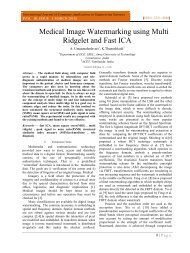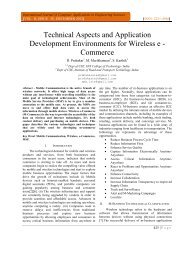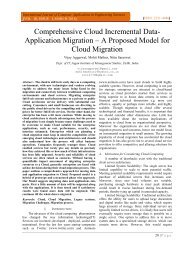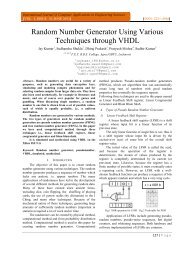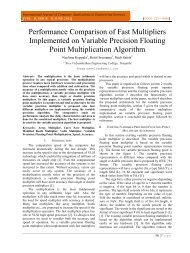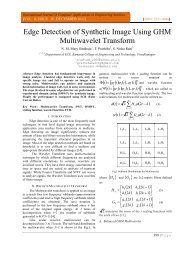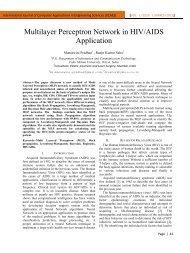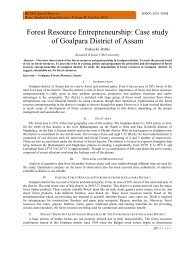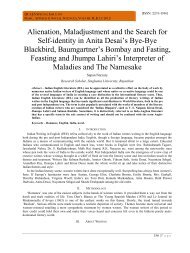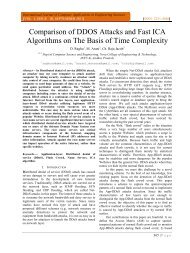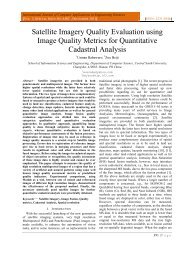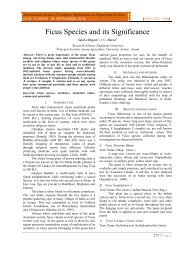IEEE Paper Template in A4 (V1) - International Journal of Computer ...
IEEE Paper Template in A4 (V1) - International Journal of Computer ...
IEEE Paper Template in A4 (V1) - International Journal of Computer ...
Create successful ePaper yourself
Turn your PDF publications into a flip-book with our unique Google optimized e-Paper software.
Nakhaee et. al.sends data packets us<strong>in</strong>g this route immediately.Otherwise, route discovery procedure beg<strong>in</strong>s. Wemodified the procedure as follows:Step1: A source node starts to flood RREQ packets toits neighbor<strong>in</strong>g nodes <strong>in</strong> a MANET until they arrive attheir dest<strong>in</strong>ation node. We add two numbers qmean andmaxq to these RREQ packets.Step2: If the <strong>in</strong>termediate node N receives a RREQpacket and it is not the dest<strong>in</strong>ation, then the new values<strong>of</strong> maxq and qmean are calculated <strong>in</strong> node N. And<strong>in</strong>formation <strong>of</strong> node N is added to the RREQ packetwhich is appended to packet fields. After that, node Nreforwards the packet to all the neighbor<strong>in</strong>g nodes <strong>of</strong>itself.In node N, maxq is changed if the maximum queuelength <strong>in</strong> the node is higher than the current maxq <strong>in</strong> theRREQ received message. Equation (1) shows how tocalculate qmean <strong>in</strong> the node N.(1)Step3: If node N receives a RREQ packet and node Nis the dest<strong>in</strong>ation, it waits a period <strong>of</strong> time. Therefore,the dest<strong>in</strong>ation node may receive many different RREQpackets from the source. Then it calculates the value <strong>of</strong>reliability value for each path from source to thedest<strong>in</strong>ation us<strong>in</strong>g the <strong>in</strong>formation <strong>in</strong> each RREQ packet.Equation (2) shows how to calculate reliability value(R_degree). F<strong>in</strong>ally, dest<strong>in</strong>ation node sends a RouteREPly (RREP) packet along the path which has amaximum reliable value.(2)Variable nohop presents hop numbers <strong>in</strong> rout<strong>in</strong>g.We exceeds with present<strong>in</strong>g a CPN model formodified AODV protocol. Our model is based on themodel which is presented by xiong et al. We considerAODV protocol has four states [9]: RoutCheck: Check the route table to see if the nodehas an exist<strong>in</strong>g and valid path to the dest<strong>in</strong>ation. RREQInit: Initiate RREQ message when necessary. RREQProcess: Process the <strong>in</strong>com<strong>in</strong>g RREQmessage and output proper results.RREPProcess: Process the <strong>in</strong>com<strong>in</strong>g RREP messageand output proper resultsIII. CPN MODEL OF A MANET WITH AODV ROUTINGPROTOCOLA. Colored Petri NetsColoured Petri Nets were <strong>in</strong>troduced by Kurt Jensen<strong>in</strong> 1987 as a developed model <strong>of</strong> Petri Nets. ColouredPetri Nets are appropriate tools for mathematical andgraphical model<strong>in</strong>g. Coloured Petri Nets have numerousapplications, and lots <strong>of</strong> research has taken place withrespect to model<strong>in</strong>g, describ<strong>in</strong>g and analyz<strong>in</strong>g systems,which have synchronized, asynchronized, distributed,parallel, non-determ<strong>in</strong>istic or random natures. In fact,Petri Nets are models which could represent theperformance and state <strong>of</strong> the system at the same time.A formal def<strong>in</strong>ition <strong>of</strong> CPN is as follows [8]:A Coloured PN (CPN) is a 6-tuplewhere1) P = denotes a f<strong>in</strong>ite and non empty set<strong>of</strong> Places.2) T = denotes a f<strong>in</strong>ite and non empty set<strong>of</strong> Transition.3) C is a colour function that assigns a f<strong>in</strong>ite and nonemptyset <strong>of</strong> colors to each place and a f<strong>in</strong>ite and nonemptyset <strong>of</strong> modes to each transition.4) Denote the backward and forward<strong>in</strong>cidence functions def<strong>in</strong>ed by , such thatDenotes a function def<strong>in</strong>ed on P, describ<strong>in</strong>g the<strong>in</strong>itial mark<strong>in</strong>g such thatB. CPN Model for Modified AODV Rout<strong>in</strong>g ProtocolThe hierarchy page (Jensen) <strong>of</strong> our CPN model isdepicted <strong>in</strong> Figure 1. It expla<strong>in</strong>s the overall organization<strong>of</strong> the modules compris<strong>in</strong>g the CPN model <strong>of</strong> ourMANET. Page Prime#1 is the top level <strong>of</strong> our Model fora MANET. And the second level (page Node#2) is thenode template for implement<strong>in</strong>g AODV protocol. Herewe can create model for any MANET composed <strong>of</strong>nodes as many as allowed by <strong>in</strong>stantiat<strong>in</strong>g this nodetemplate us<strong>in</strong>g CPN TOOLS [10]. The third level hasthree pages (page RREQInit#4, page RREQProcess#5and RREPProcess#6), each <strong>of</strong> which is named by anAODV state as given <strong>in</strong> [9]. Page SendMsg#3 sendsnode messages <strong>in</strong> the network.Fig. 1. The hierarchy pageIf we want to create a node <strong>in</strong>stance <strong>in</strong> a MANET, wecan simply do it by <strong>in</strong>stantiat<strong>in</strong>g the node template. Likean object <strong>in</strong> an object oriented programm<strong>in</strong>g language,every <strong>in</strong>stantiated node has its own local variables andprovides <strong>in</strong>terface to the outside world. In our CPN242 | P a g e



